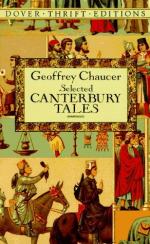|
This section contains 348 words (approx. 1 page at 400 words per page) |

|
The Canterbury Tales Summary & Study Guide Description
The Canterbury Tales Summary & Study Guide includes comprehensive information and analysis to help you understand the book. This study guide contains the following sections:
This detailed literature summary also contains Bibliography on The Canterbury Tales by Geoffrey Chaucer.
Geoffrey Chaucer began writing The Canterbury Tales sometime around 1387; the uncompleted manuscript was published in 1400, the year he died. Having recently passed the six hundredth anniversary of its publication, the book is still of interest to modern students for several reasons. For one thing, The Canterbury Tales is recognized as the first book of poetry written in the English language. Before Chaucer's time, even poets who lived in England wrote in Italian or Latin, which meant that poetry was only understandable to people of the wealthy, educated class. English was considered low class and vulgar. To a great degree, The Canterbury Tales helped make it a legitimate language to work in. Because of this work, all of the great writers who followed, from Shakespeare to Dryden to Keats to Eliot, owe him a debt of gratitude. It is because Chaucer wrote in English that there is a written record of the roots from which the modern language grew. Contemporary readers might find his words nearly as difficult to follow as a foreign language, but scholars are thankful for the chance to compare Middle English to the language as it is spoken now, to examine its growth.
In the same way that The Canterbury Tales gives modern readers a sense of the language at the time, the book also gives a rich, intricate tapestry of medieval social life, combining elements of all classes, from nobles to workers, from priests and nuns to drunkards and thieves. The General Prologue alone provides a panoramic view of society that is not like any found elsewhere in all of literature. Students who are not particularly interested in medieval England can appreciate the author's technique in capturing the variations of human temperament and behavior. Collections of stories were common in Chaucer's time, and some still exist today, but the genius of The Canterbury Tales is that the individual stories are presented in a continuing narrative, showing how all of the various pieces of life connect to one another. This entry does not cover all the tales, only some of the most studied.
Read more from the Study Guide
|
This section contains 348 words (approx. 1 page at 400 words per page) |

|



